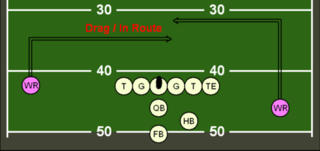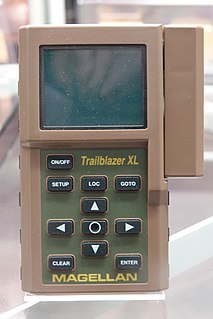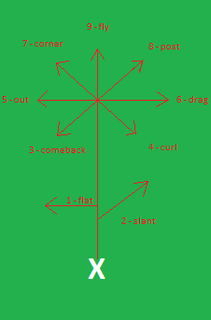Related Research Articles
An Internet Protocol address is a numerical label such as 192.0.2.1 that is connected to a computer network that uses the Internet Protocol for communication. An IP address serves two main functions: network interface identification and location addressing.

A running back (RB) is a member of the offensive backfield in gridiron football. The primary roles of a running back are to receive handoffs from the quarterback to rush the ball, to line up as a receiver to catch the ball, and block. There are usually one or two running backs on the field for a given play, depending on the offensive formation. A running back may be a halfback, a wingback or a fullback. A running back will sometimes be called a "feature back" if he is the team's starting running back.

A cornerback (CB) is a member of the defensive backfield or secondary in gridiron football. Cornerbacks cover receivers most of the time, but also blitz and defend against such offensive running plays as sweeps and reverses. They create turnovers through hard tackles, interceptions, and deflecting forward passes.

A wide receiver (WR), also referred to as a wideout, historically known as a split end, is an eligible receiver in gridiron football. A key skill position of the offense, WR gets its name from the player being split out "wide", farthest away from the rest of the offensive formation.

The tight end (TE) is a position in American football, arena football, and Canadian football, on the offense. The tight end is often a hybrid position with the characteristics and roles of both an offensive lineman and a wide receiver. Like offensive linemen, they are usually lined up on the offensive line and are large enough to be effective blockers. On the other hand, unlike offensive linemen, they are eligible receivers adept enough to warrant a defense's attention when running pass patterns.
The Resource Reservation Protocol (RSVP) is a transport layer protocol designed to reserve resources across a network using the integrated services model. RSVP operates over an IPv4 or IPv6 and provides receiver-initiated setup of resource reservations for multicast or unicast data flows. It does not transport application data but is similar to a control protocol, like Internet Control Message Protocol (ICMP) or Internet Group Management Protocol (IGMP). RSVP is described in RFC 2205.

Charles B. Joiner Jr. is an American former professional football player who was a wide receiver in the American Football League (AFL) and National Football League (NFL) for 18 seasons. He is best known for his career with the San Diego Chargers, with whom he spent 11 seasons. Before joining the Chargers, he played for the Houston Oilers and Cincinnati Bengals each for four seasons. He retired with the most career receptions, receiving yards, and games played of any wide receiver in NFL history. Joiner was inducted into the Pro Football Hall of Fame in 1996.
Strategy forms a major part of American football. Both teams plan many aspects of their plays (offense) and response to plays (defense), such as what formations they take, who they put on the field, and the roles and instructions each player are given. Throughout a game, each team adapts to the other's apparent strengths and weaknesses, trying various approaches to outmaneuver or overpower their opponent in order to win the game.

DeLorme is a producer of personal satellite tracking, messaging, and navigation technology. The company’s main product, inReach, integrates GPS and satellite technologies. inReach provides the ability to send and receive text messages anywhere in the world by using the Iridium satellite constellation. By pairing with a smart phone, navigation is possible with access to free downloadable topographic maps and NOAA charts. On February 11, 2016, the company announced that it had been purchased by Garmin, a multinational producer of GPS products and services.
Bump and run coverage is a strategy formerly widely used by defensive backs in American professional football in which a defender lined up directly in front of a wide receiver and tried to impede him with arms, hands, or entire body and disrupt his intended route. This originated in the American Football League in the 1960s, one of whose earliest experts was Willie Brown of the Oakland Raiders. Mel Blount of the Pittsburgh Steelers specialized in this coverage to such a point as to cause numerous rule changes strictly limiting when and where a defender may make contact with a potential receiver in order to make it easier for receivers to run their routes and increase scoring.
IP multicast is a method of sending Internet Protocol (IP) datagrams to a group of interested receivers in a single transmission. It is the IP-specific form of multicast and is used for streaming media and other network applications. It uses specially reserved multicast address blocks in IPv4 and IPv6.
"The Greatest Show on Turf" was a nickname for the record-breaking offense of the St. Louis Rams during the 1999, 2000, and 2001 National Football League seasons. The offense was designed by attack-oriented offensive coordinator and head coach Mike Martz, who mixed an aerial attack and a run offense in an Air Coryell-style offense. The Rams' offense during these three seasons produced record scoring and yardage, three NFL MVP honors, and two Super Bowl appearances and one championship. In 2000, the team set an NFL record with 7,335 total offensive yards. Of those, 5,492 were passing yards, also an NFL team record.

A drag route is a route run by a receiver in American football, where the receiver runs a few yards downfield, then turns 90° towards the center of the field and runs parallel to the line of scrimmage. This type of route is relatively safe, and often leads to a receiver making a play after the catch. Alternatively, a drag route may be used as a second option if the principal receiver on a play is covered.
Acoustic tags are small sound-emitting devices that allow the detection and/or remote tracking of organisms in aquatic ecosystems. Acoustic tags are commonly used to monitor the behavior of fish. Studies can be conducted in lakes, rivers, tributaries, estuaries or at sea. Acoustic tag technology allows researchers to obtain locational data of tagged fish: depending on tag and receiver array configurations, researchers can receive simple presence/absence data, 2D positional data, or even 3D fish tracks in real-time with sub-meter resolution.
In American football, a play is a close-to-the-ground plan of action or strategy used to move the ball down the field. A play begins at either the snap from the center or at kickoff. Most commonly, plays occur at the snap during a down. These plays range from basic to very intricate. Football players keep a record of these plays in a playbook.

A satellite navigation device, colloquially called a GPS receiver, or simply a GPS, is a device that is capable of receiving information from GNSS satellites and then calculate the device's geographical position. Using suitable software, the device may display the position on a map, and it may offer routing directions. The Global Positioning System (GPS) is one of a handful of global navigation satellite systems (GNSS) made up of a network of a minimum of 24, but currently 30, satellites placed into orbit by the U.S. Department of Defense.
The following terms are used in American football, both conventional and indoor. Some of these terms are also in use in Canadian football; for a list of terms unique to that code, see Glossary of Canadian football.
The run and shoot offense is an offensive system for American football which emphasizes receiver motion and on-the-fly adjustments of receivers' routes in response to different defenses. It was conceived by former high school coach Glenn "Tiger" Ellison and refined and popularized by former Portland State offensive coordinator Mouse Davis.
A play calling system in American football is the specific language and methods used to call offensive plays.

A route is a pattern or path that a receiver in gridiron football runs to get open for a forward pass. Routes are usually run by wide receivers, running backs and tight ends, but other positions can act as a receiver given the play.